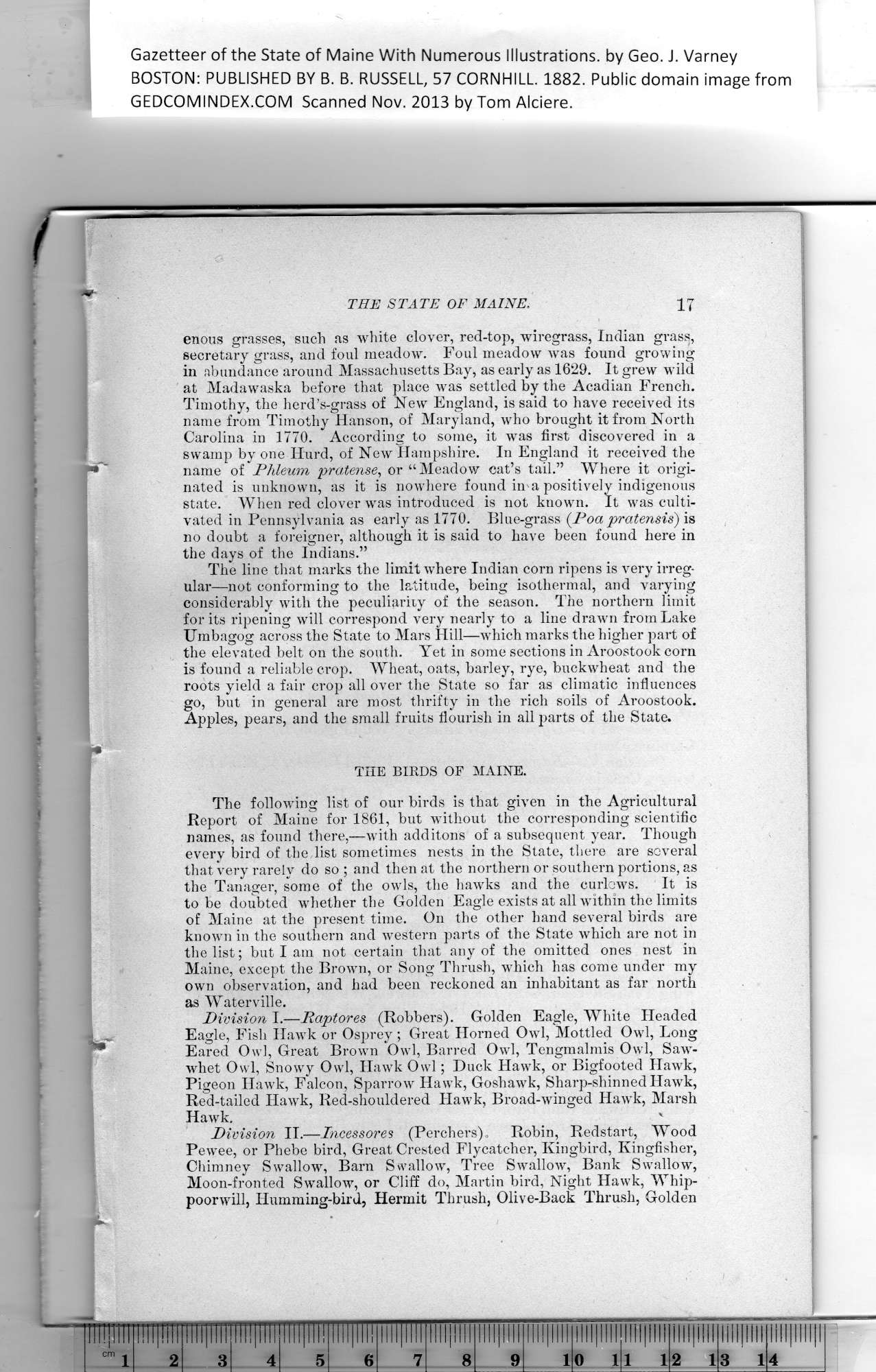|
Gazetteer of the State of Maine With Numerous Illustrations, by Geo. J. Varney
BOSTON: PUBLISHED BY B. B. RUSSELL, 57 CORNHILL. 1882. Public domain image from
THE STATE OF MAINE, 17
enous grasses, such as white clover, red-top, wiregrass, Indian grass,
secretary grass, and foul meadow. Foul meadow wTas found growing
in abundance around Massachusetts Bay, as early as 1629. It grew wild
at Madawaska before that place was settled by the Acadian French.
Timothy, the herd’s-grass of New England, is said to have received its
name from Timothy Hanson, of Maryland, who brought it from North
Carolina in 1770. According to some, it was first discovered in a
swamp by one Hurd, of New Hampshire. In England it received the
name of Phleum pro,tense, or “Meadow cat’s tail.” Where it origi-
nated is unknown, as it is nowhere found in a positively indigenous
state. When red clover was introduced is not known. It was culti-
vated in Pennsylvania as early as 1770. Blue-grass (Poa pratensis) is
no doubt a foreigner, although it is said to have been found here in
the days of the Indians.”
The line that marks the limit where Indian corn ripens is very irreg-
ular—not conforming to the latitude, being isothermal, and varying
considerably with the peculiarity of the season. The northern limit
for its ripening will correspond very nearly to a line drawn from Lake
Umbagog across the State to Mars Hill—which marks the higher part of
the elevated belt on the south. Yet in some sections in Aroostook corn
is found a reliable crop. Wheat, oats, barley, rye, buckwheat and the
roots yield a fair crop all over the State so far as climatic influences
go, but in general are most thrifty in the rich soils of Aroostook.
Apples, pears, and the small fruits flourish in all parts of the State.
THE BIRDS OF MAINE.
The following list of our birds is that given in the Agricultural
Report of Maine for 1861, but without the corresponding scientific
names, as found there,—with additons of a subsequent year. Though
every bird of the list sometimes nests in the State, there are several
that very rarely do so; and then at the northern or southern portions, as
the Tanager, some of the owls, the hawks and the curlews. It is
to be doubted whether the Golden Eagle exists at all within the limits
of Maine at the present time. On the other hand several birds are
known in the southern and western parts of the State which are not in
the list; but I am not certain that any of the omitted ones nest in
Maine, except the Brown, or Song Thrush, which has come under my
own observation, and had been reckoned an inhabitant as far north
as Waterville.
Division I.—Raptores (Robbers). Golden Eagle, White Headed
Eagle, Fish Hawk or Osprey; Great Horned Owl, Mottled Owl, Long
Eared Owl, Great Brown Owl, Barred Owl, Tengmalmis Owl, Saw-
whet Owl, Snowy Owl, Hawk Owl; Duck Hawk, or Bigfooted Hawk,
Pigeon Hawk, Falcon, Sparrow Hawk, Goshawk, Sharp-shinned Hawk,
Red-tailed Hawk, Red-shouldered Hawk, Broad-winged Hawk, Marsh
Hawk.
Division II.—Incessores (Perchers). Robin, Redstart, Wood
Pewee, or Phebe bird, Great Crested Flycatcher, Kingbird, Kingfisher,
Chimney Swallow, Barn Swallow, Tree Swallow, Bank Swallow,
Moon-fronted Swallow, or Cliff do, Martin bird, Night Hawk, Whip-
poorwill, Humming-bird, Hermit Thrush, Olive-Back Thrush, Golden
PREVIOUS PAGE ... NEXT PAGE
This page was written in HTML using a program written in Python 3.2
|
